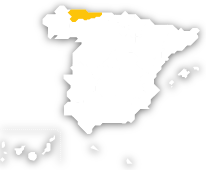Without a doubt, Asturias is a magnificent natural sea, mountain and country paradise with a very diverse environment. Protected on one side by the Bay of Biscay and on the other by the Picos de Europa mountain range, this region has always been isolated and protected from possible invasions and therefore has many deep-routed traditions and rituals. The typical Asturian is friendly and open, always willing to receive outsiders who wish to get to know their land. Its cuisine is based on cider, fabada (bean stew) and cheese, together with shellfish and fish.
If Asturian cuisine had to be described in few words, it could be defined as slow cooking over low heat. The Asturians do not use many spices or other condiments in their dishes which could distort the natural taste of the ingredients. The kitchens use old-style stoves which conjure up an atmosphere from another era, contrasting strongly with the stress of modern day life. Asturians delight in their stews, the "fabada" being the queen of them all.
Fabada
"Fabada asturiana" is prepared with dried white beans called "fabes", accompanied by chorizo, black pudding, cured pork shoulder, potatoes... this dish is of international renown and there is no set recipe - it can be varied according to the chef's fancy: clams, lobster, hare and partridge have all been used in its preparation. Although the "fabada" is the most famous of Asturian dishes, it is by no means alone - soups or "potes" also form an important part of the local cooking. These include "asturiano", which is made with dried white beans (fabes), cabbage, chorizo, cured pork shoulder and potatoes; "pote de castañes mayuques", made with chestnuts and parsnip top stew, typical from Ibias.
The generous sea
The Asturian chef carefully chooses his ingredients from many sources: from the sea, the rivers, the market gardens, the mountains... Both freshwater and seawater fish and shellfish are used in local recipes. From the sea, we have anglerfish, which is known as "pixín" in Asturias, hake, conger eel, bonito, sea base, scorpion fish, etc. Shellfish include barnacles, shrimps, small crabs and clams. The "oricio" (sea urchin) has become a real institution, especially in the winter months at Gijón, where they are eaten raw or cooked in various different ways. River fish such as salmon, trout, sea-trout and lamprey complete the range of aquatic species which can be tried whilst visiting Asturias.However, it is also very important to keep the local meat dishes in mind. The "vacuno mayor" (meat from large bovine animals, such as ox, bull, etc.) is very much appreciated by Asturians and it is also exported to nearly all other Spanish regions: entrecote with Cabrales cheese, ox hotpot... "pitu de caleya" (chickens bred in the open air in small villages or hamlets). The partridge, wild boar, roe deer and venison are always prepared with aromatic herbs and truly taste of the mountains. The flavour and character of "carne gobernada" (beef with bacon, eggs, peppers and olives) and tongue "cachopo" are very much appreciated by the locals.
The cheese legacy
Cheese is another extremely important component of Asturian cuisine. In fact, every valley or mountain usually makes its own cheese and as a result, Asturias offers one of the widest ranges in Europe. They can be made from cow's milk, goat's milk or even using three different types of milk, but without doubt the most famous of all is the celebrated Cabrales, a blue cheese included in a Denomination of Origin together with Gamonedo, Pría, Porrúa, Beyos, Casín or Afuega´l Pitu, Peral, Urbiés, etc. The Principality of Asturias also boasts a wide variety of confectionary products which are found in specialist shops throughout the region. The Asturian is known for his sweet tooth and therefore there are endless specialities on offer. The most traditional Asturian dessert is rice pudding, but the traveller should also try almond tart, "brazo de gitano"(a type of Swiss roll), "milhojas de crema" (custard millefeuille), "pastel carbayón" (almond pastry), "carajitos del profesor de Salas" (hazelnut biscuits), or the festival specialities, such as "frixuelos" (crepes), "casadielles" (walnut popovers), "panchones de Carnaval" (type of brown bread) or the "huesos de santo" (made from marzipan) and "teresitas" (made from tea) eaten on All Saints' Day, and "tocinillo de cielo" (pudding made with egg yolks and syrup).
Cider
Austurian cider is the local drink which is drunk socially and used in the preparation of many dishes; it has almost become a cult. It can be drunk in the cider bars called "sidrerías", in restaurants and at times in the "llagares" themselves (where it is pressed). The cider is poured from a height (a practice known as "escanciar") into a wide-mouthed glass only just covering the "culín" or bottom and induces friendship and festivity. Everybody should experience this type of fiesta when visiting Asturias.
Christmas food in Asturias
If you want to taste the flavours of an Asturian Christmas, take note: try some fabes a los pisones (bean stew with seafood) or Asturian lamb. It can be accompanied with some of the almost 50 varieties of cheese (the most international is the Cabrales). The perfect drink is cider (Asturias is Spain’s land of cider-making). And to finish, a dessert such as the traditional casadiellas (pastry rolls filled with walnut). Incidentally, you can try a version of the traditional Epiphany cake made with puff pastry.



